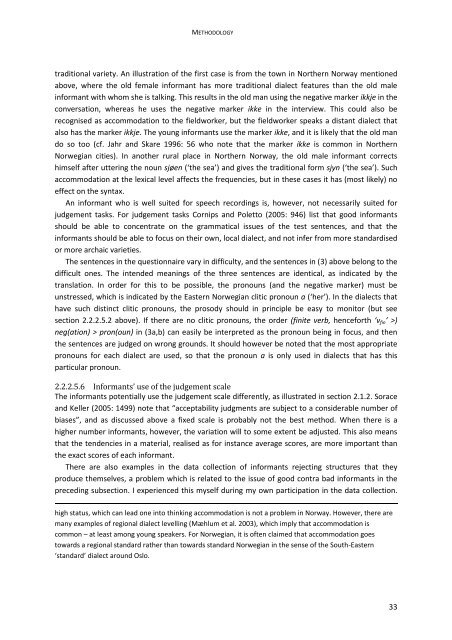North Germanic Negation - Munin
North Germanic Negation - Munin
North Germanic Negation - Munin
Create successful ePaper yourself
Turn your PDF publications into a flip-book with our unique Google optimized e-Paper software.
METHODOLOGY<br />
traditional variety. An illustration of the first case is from the town in <strong>North</strong>ern Norway mentioned<br />
above, where the old female informant has more traditional dialect features than the old male<br />
informant with whom she is talking. This results in the old man using the negative marker ikkje in the<br />
conversation, whereas he uses the negative marker ikke in the interview. This could also be<br />
recognised as accommodation to the fieldworker, but the fieldworker speaks a distant dialect that<br />
also has the marker ikkje. The young informants use the marker ikke, and it is likely that the old man<br />
do so too (cf. Jahr and Skare 1996: 56 who note that the marker ikke is common in <strong>North</strong>ern<br />
Norwegian cities). In another rural place in <strong>North</strong>ern Norway, the old male informant corrects<br />
himself after uttering the noun sjøen (‘the sea’) and gives the traditional form sjyn (‘the sea’). Such<br />
accommodation at the lexical level affects the frequencies, but in these cases it has (most likely) no<br />
effect on the syntax.<br />
An informant who is well suited for speech recordings is, however, not necessarily suited for<br />
judgement tasks. For judgement tasks Cornips and Poletto (2005: 946) list that good informants<br />
should be able to concentrate on the grammatical issues of the test sentences, and that the<br />
informants should be able to focus on their own, local dialect, and not infer from more standardised<br />
or more archaic varieties.<br />
The sentences in the questionnaire vary in difficulty, and the sentences in (3) above belong to the<br />
difficult ones. The intended meanings of the three sentences are identical, as indicated by the<br />
translation. In order for this to be possible, the pronouns (and the negative marker) must be<br />
unstressed, which is indicated by the Eastern Norwegian clitic pronoun a (‘her’). In the dialects that<br />
have such distinct clitic pronouns, the prosody should in principle be easy to monitor (but see<br />
section 2.2.2.5.2 above). If there are no clitic pronouns, the order (finite verb, henceforth ‘v fin ’ >)<br />
neg(ation) > pron(oun) in (3a,b) can easily be interpreted as the pronoun being in focus, and then<br />
the sentences are judged on wrong grounds. It should however be noted that the most appropriate<br />
pronouns for each dialect are used, so that the pronoun a is only used in dialects that has this<br />
particular pronoun.<br />
2.2.2.5.6 Informants’ use of the judgement scale<br />
The informants potentially use the judgement scale differently, as illustrated in section 2.1.2. Sorace<br />
and Keller (2005: 1499) note that “acceptability judgments are subject to a considerable number of<br />
biases”, and as discussed above a fixed scale is probably not the best method. When there is a<br />
higher number informants, however, the variation will to some extent be adjusted. This also means<br />
that the tendencies in a material, realised as for instance average scores, are more important than<br />
the exact scores of each informant.<br />
There are also examples in the data collection of informants rejecting structures that they<br />
produce themselves, a problem which is related to the issue of good contra bad informants in the<br />
preceding subsection. I experienced this myself during my own participation in the data collection.<br />
high status, which can lead one into thinking accommodation is not a problem in Norway. However, there are<br />
many examples of regional dialect levelling (Mæhlum et al. 2003), which imply that accommodation is<br />
common – at least among young speakers. For Norwegian, it is often claimed that accommodation goes<br />
towards a regional standard rather than towards standard Norwegian in the sense of the South-Eastern<br />
‘standard’ dialect around Oslo.<br />
33
















